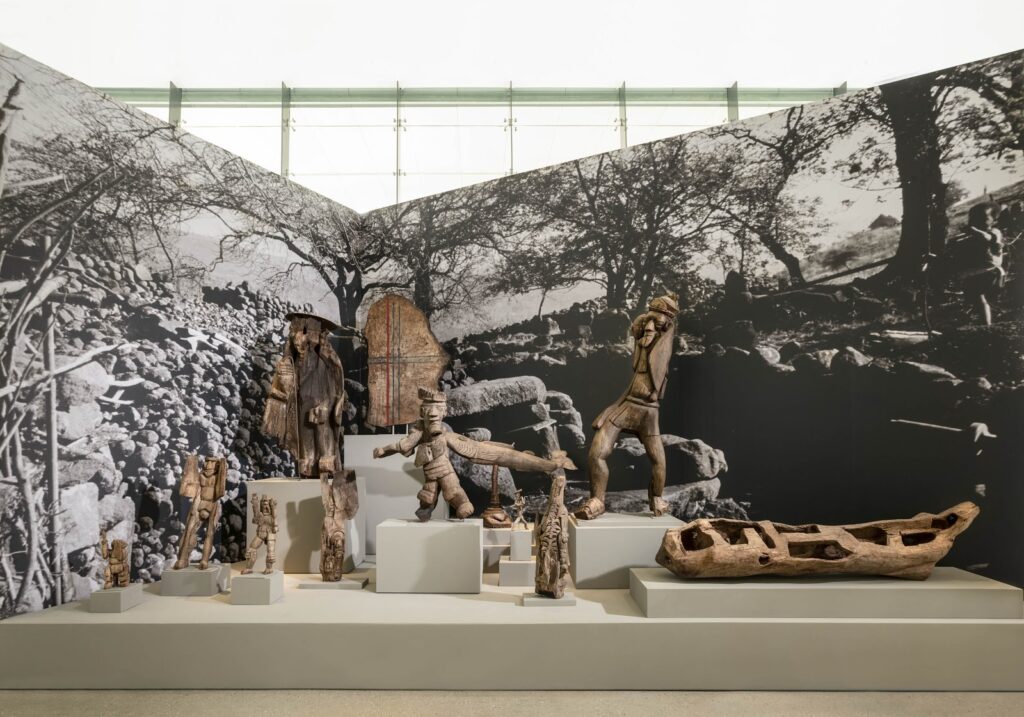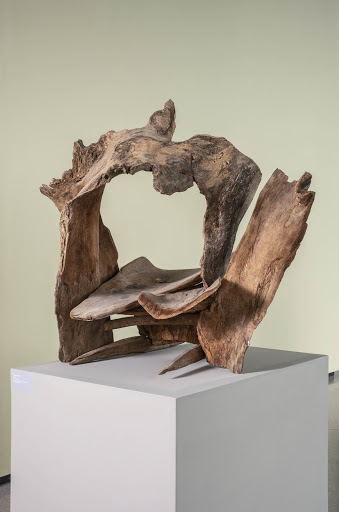A collection of Jackson Hlungwani’s sculptures of fish, showing at the Norval Foundation as part of the Alt and Omega exhibition. (Photo: Michael Hall)
The migration of art viewing to digital spheres that Covid-19 and social distancing encouraged inspired a deep longing to view art in person, in situ. However, it is only when you stand in front of a sculpture such as Jackson Hlungwani’s Hand of God that you are reminded why art holds so much sway in our digitally driven world. When it is good, powerful, and/or driven by metaphysical concerns, it can offer a form of transcendence that can’t be replicated virtually.
Nothing can replace standing in front of an object that appears to defy the boundaries of logic, is beyond the limits of human intervention, yet somehow also affirms our place in the universe and the role of art and aesthetics in mediating this state. These are my recurring thoughts during a physical encounter with Hlungwani’s Hand of God.
It is one of the highlights of a new survey exhibition of the late artist’s practice at the Norval Foundation in Cape Town. It probably helps that Hlungwani was a lay preacher and had a refined understanding of art’s metaphysical functions. Even if you are more of an atheist, the waves of delight, awe and reverence you experience as you wander through this show will leave you feeling as if Hlungwani were a channel through which an unearthly power flowed.
How is it possible that someone with no formal art training was capable of such a vast array of sculptural expressions, evoking different historical periods of Western and African artistic periods? He came late to art, too. Born in 1925, Hlungwani appears to have got stuck in only in the late 1970s, after hitting rock bottom, when a vision of Christ sent him on an artistic and religious path.
This comprehensive survey, titled Alt and Omega, is curated by Karel Nel, Nessa Liebhammer and Amos Letsoalo. It establishes the breadth of Hlungwani’s range as a sculptor through a loose chronological order tracing the aesthetic and conceptual shifts in his practice.
In his early wood carvings, Hlungwani initially takes his cue from Tsonga and Shangaan culture, producing headrests. Staffs produced by Tsonga-Shangaan and Venda artists from the late 19th and 20th century, which are also on display, establish an historical antecedent for the “egg” motif that recurs in his later sculptures, as well as the use of symbols in evoking spiritual worlds, existence.
However, in this same gallery are intricate carvings with strong biblical references that, as co-curator Nel rightly observes, “seem to come from mediaeval times.” Certainly, a quartet of sculptures presenting the crucifix motif bring mediaeval churches and objects to mind, though each one is given its own treatment and is combined with other idiosyncratic features, such as steps up the cross.
 Wood Flowers and Tree of Life (Photos: Michael Hall)
Wood Flowers and Tree of Life (Photos: Michael Hall)
This leaves you with the sense that Hlungwani was testing, exploring different kinds of visual vocabulary that were secular in nature. Although nonbelievers will luxuriate in his skills and the impact of his works, Hlungwani appears to have viewed art as a medium through which belief in an omnipotent power could not only be expressed, but also formed the earthly touchstone, offering proof of its existence.
In the sculpture Hand of God Hlungwani shifts to an idiom that parades as contemporary. This artwork seems not to have passed through human hands, though, ironically, it evokes one.
The wood appears to be plucked from a natural environment. You have to circle the sculpture to perceive the digits of the titular hand and, in particular, the gentle hollow evoking the distinctive line that leads to a thumb. In this way, what could from one angle appear to be an ordinary shaped piece of driftwood is also a monumental portal to another existence beyond human conception or sight.
As such, it is clear that although Hlungwani might have initially been interested in Tsonga, Shangaan and Christian visual traditions designed to either evoke or connect with spiritual realms, he exploited both in establishing his own unique expression.
It is his medium — wood — that facilitates his art. In the African tradition, Hlungwani tunes into his material, exploits its properties, builds on them and extracts compelling forms. He moves between the figurative and the abstract with ease. A good example of this duality is the juxtaposition of two renditions of the angel Gabriel. Whereas one appears like a totem, with spires shooting out from a central spine, the other presents a stubby figure ready for battle. It is striking that in Jackson’s realm angels and gods appear to live among us — numerous works show God playing soccer.
As is the case with the sculpture shows staged at the Norval, the large gallery with an expansive glass wall offering views of the quasi bucolic setting houses the larger works and rambling installations marking the apotheosis of the artist’s expression.
It is here that large-scale sculptures are accommodated and installations of figures conceived for New Jerusalem, a holy site of Hlungwani’s own creation in what was then Gazankulu. It was for his own church, which he dubbed “Yesu Geleiya One Apostle in Sayoni Alt and Omega”. A detailed architect’s drawing of this development is included in the exhibition, giving you an idea of the grand scope of this artistic and secular project. Jackson may have sold art and staged exhibitions, but for him art and spiritualism were inseparable and his ambitions lay beyond being a recognised artist. It is clear he had architectural, theological and social aspirations.
 An installation of sculptures conceived for New Jerusalem. (Photo: Michael Hall)
An installation of sculptures conceived for New Jerusalem. (Photo: Michael Hall)
In some ways this complicates presenting an exhibition by this artist, because the spiritual and theological underpinnings of his practice cannot be faithfully accommodated in an art gallery. Of course, Hlungwani produced artworks for the market, which were intended for private homes and display. Like many successful artists he employed assistants too — so the works did not always pass through his “godly” hands.
However, in an art museum the focus is naturally on the aesthetic and formal qualities of the sculptures, so any viewing needs to be conducted with an awareness that some of the meanings, functions and concepts probably escape this superficial tact. Not that this will leave you feeling as if the magic of Hlungwani’s art has escaped you. Contemporary museums are akin to churches, after all, and his art’s power is that it transcends ideas.
You also know, given Hlungwani’s sensitive relationship to the natural world, that some of his works are best enjoyed in a natural setting. The Norval is probably the closest a museum in South Africa might be able to achieve, in this regard, through the large gallery’s views of nature.
The quasi “thrones” Hlungwani created in the late eighties to early nineties are satisfying objects.
As with the Hand of God, you need to catch them at the right angle to perceive that they offer a seat — though they probably could not hold the weight of a person. These are fragile sculptures, evincing a nuanced intervention with nature to arrive at pleasing abstract forms. In this way, Hlungwani’s art is also able to resonate with our times. Climate change has demanded that we re-establish and reconsider how we work with and in the natural world and he provides a template for this.
 A throne by Jackson Hlungwani, made in the late eighties. (Photo: Michael Hall)
A throne by Jackson Hlungwani, made in the late eighties. (Photo: Michael Hall)
Exhibitions dedicated to Hlungwani’s practice have taken place before — most recently the 2014 exhibition Liebhammer and Letsoalo curated.
This one appears more comprehensive and, given the status of this institution, it shines a brighter light on an artist who deserves to be appreciated more widely.
Alt and Omega is showing at the Norval Foundation in Cape Town until July 26 next year